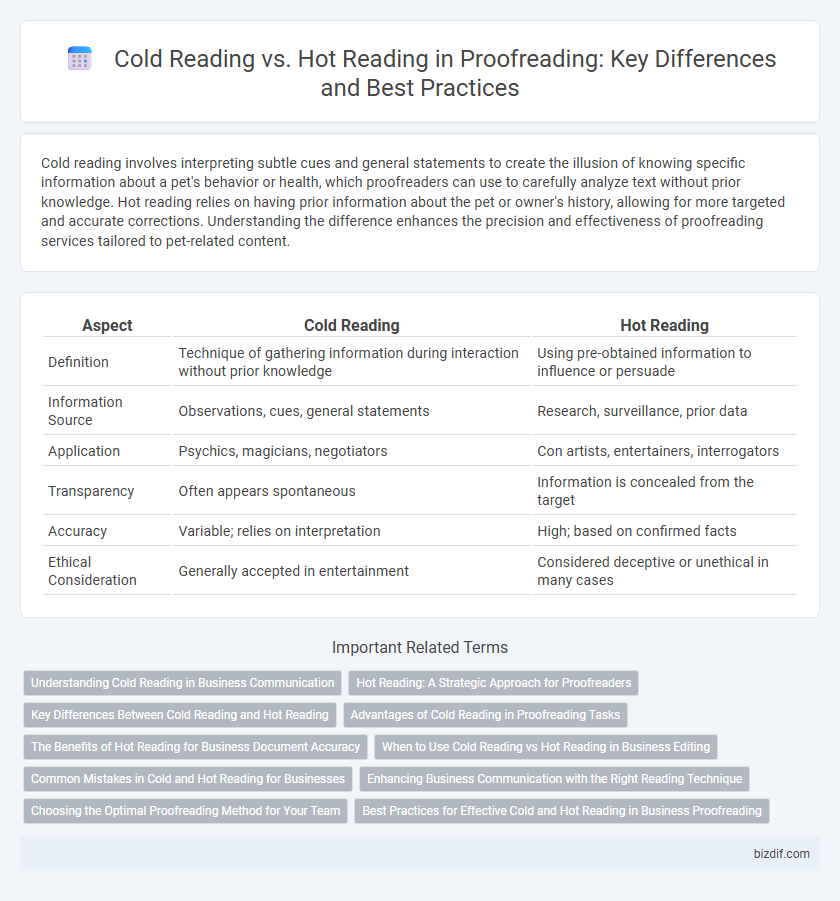Cold reading involves interpreting subtle cues and general statements to create the illusion of knowing specific information about a pet's behavior or health, which proofreaders can use to carefully analyze text without prior knowledge. Hot reading relies on having prior information about the pet or owner's history, allowing for more targeted and accurate corrections. Understanding the difference enhances the precision and effectiveness of proofreading services tailored to pet-related content.
Table of Comparison
| Aspect | Cold Reading | Hot Reading |
|---|---|---|
| Definition | Technique of gathering information during interaction without prior knowledge | Using pre-obtained information to influence or persuade |
| Information Source | Observations, cues, general statements | Research, surveillance, prior data |
| Application | Psychics, magicians, negotiators | Con artists, entertainers, interrogators |
| Transparency | Often appears spontaneous | Information is concealed from the target |
| Accuracy | Variable; relies on interpretation | High; based on confirmed facts |
| Ethical Consideration | Generally accepted in entertainment | Considered deceptive or unethical in many cases |
Understanding Cold Reading in Business Communication
Understanding cold reading in business communication involves interpreting subtle cues such as body language, tone, and word choice to gauge the other party's intentions and emotions without prior knowledge. This skill enhances negotiation tactics, enabling professionals to adapt messages in real-time based on inferred reactions. Effective cold reading reduces misunderstandings and builds rapport by allowing accurate, spontaneous assessments of client needs and concerns.
Hot Reading: A Strategic Approach for Proofreaders
Hot reading serves as a strategic approach for proofreaders by leveraging prior knowledge of the text or author to identify errors more efficiently. This method enhances accuracy and speeds up the detection of typos, grammatical mistakes, and stylistic inconsistencies. Utilizing hot reading techniques allows proofreaders to provide more precise and contextually relevant corrections, ultimately improving the quality of the final document.
Key Differences Between Cold Reading and Hot Reading
Cold reading relies on interpreting subtle cues and making generalized statements based on observation and psychological techniques, without prior knowledge of the subject. Hot reading involves obtaining specific, confidential information about the subject beforehand to create the illusion of psychic insight. Key differences include the source of information, approach to knowledge, and level of preparation, with cold reading depending on cold observation and inference while hot reading uses pre-acquired facts.
Advantages of Cold Reading in Proofreading Tasks
Cold reading in proofreading allows professionals to approach the text with fresh eyes, enhancing their ability to identify errors and inconsistencies that might be overlooked due to familiarity. This method promotes unbiased judgment, ensuring objective correction of grammar, punctuation, and style without prior knowledge influencing the review. Cold reading improves overall accuracy and quality of the final document by fostering a meticulous and detached evaluation process.
The Benefits of Hot Reading for Business Document Accuracy
Hot reading enhances business document accuracy by utilizing pre-obtained information, allowing proofreading professionals to identify specific errors and inconsistencies more efficiently. This targeted approach reduces the risk of overlooking critical mistakes, ensuring higher precision in financial reports, contracts, and marketing materials. Implementing hot reading techniques streamlines the editing process and improves overall document reliability.
When to Use Cold Reading vs Hot Reading in Business Editing
Cold reading is ideal in business editing when dealing with unfamiliar documents or first drafts, as it enables editors to interpret content impartially and identify inconsistencies without prior knowledge. Hot reading is effective when editors have background information on the author's style or company tone, allowing for tailored revisions that enhance brand alignment and messaging precision. Choosing between cold and hot reading depends on the project's context, with cold reading fostering objective critique and hot reading supporting customized, context-aware editing strategies.
Common Mistakes in Cold and Hot Reading for Businesses
Common mistakes in cold reading for businesses include relying too heavily on assumptions without verifying customer data, leading to misinterpretation of client needs and decreased trust. In hot reading, errors often arise from using outdated or incorrect prior information, resulting in inaccurate personalization and missed sales opportunities. Both approaches can damage brand credibility if communication fails to align authentically with the customer's actual preferences and behaviors.
Enhancing Business Communication with the Right Reading Technique
Choosing cold reading techniques enhances business communication by fostering authenticity and real-time adaptability, leading to more genuine interactions. Hot reading relies on prior knowledge, which can streamline conversations but risks reducing trust if discovered. Implementing cold reading can improve negotiation, client rapport, and decision-making by emphasizing active listening and spontaneous analysis.
Choosing the Optimal Proofreading Method for Your Team
Selecting the optimal proofreading method for your team involves understanding the distinctions between cold reading and hot reading techniques. Cold reading requires fresh eyes to catch errors unbiased by prior exposure, enhancing objectivity and error detection accuracy. In contrast, hot reading leverages familiarity with the text, enabling quicker identification of stylistic inconsistencies and subtle mistakes, making it ideal for teams with strict deadlines and repetitive content.
Best Practices for Effective Cold and Hot Reading in Business Proofreading
Effective cold reading in business proofreading involves quickly interpreting unfamiliar texts with accuracy, relying on strong language comprehension and contextual analysis to identify errors without prior knowledge. Hot reading requires preparation, including reviewing the document background and industry-specific terminology to enhance precision and reduce misspellings or misinterpretations. Combining both methods ensures thorough error detection, improving overall document clarity, professionalism, and client trust in proofreading services.
cold reading vs hot reading Infographic

 bizdif.com
bizdif.com